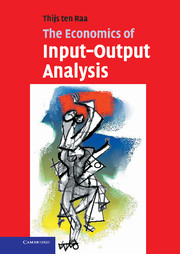Book contents
- Frontmatter
- Contents
- List of figures
- List of tables
- Preface
- Glossary
- 1 Introduction
- 2 Input-output basics
- 3 Multiplier effects
- 4 Linear programming
- 5 Are input-output coefficients fixed?
- 6 The System of National Accounts
- 7 The construction of technical coefficients
- 8 From input-output coefficients to the Cobb–Douglas function
- 9 The diagnosis of inefficiency
- 10 Input-output analysis of international trade
- 11 Environmental input-output economics
- 12 Productivity growth and spillovers
- 13 The dynamic inverse
- 14 Stochastic input-output analysis
- Solutions to exercises
- Index
- References
8 - From input-output coefficients to the Cobb–Douglas function
Published online by Cambridge University Press: 18 December 2009
- Frontmatter
- Contents
- List of figures
- List of tables
- Preface
- Glossary
- 1 Introduction
- 2 Input-output basics
- 3 Multiplier effects
- 4 Linear programming
- 5 Are input-output coefficients fixed?
- 6 The System of National Accounts
- 7 The construction of technical coefficients
- 8 From input-output coefficients to the Cobb–Douglas function
- 9 The diagnosis of inefficiency
- 10 Input-output analysis of international trade
- 11 Environmental input-output economics
- 12 Productivity growth and spillovers
- 13 The dynamic inverse
- 14 Stochastic input-output analysis
- Solutions to exercises
- Index
- References
Summary
Introduction
The macroeconomic production function of an economy summarizes the maximum level of net output that is possible for any combination of factor inputs. It is customary to consider two factor inputs, capital and labor (Solow 1957). The disaggregation and extension to more factor inputs is conceptually straightforward (Johansen, 1972). The macroeconomic concept of a level of net output is more problematic. The net output of an economy is a commodity vector and the measurement of a “level” requires a price system. But which price system? This problem of value has puzzled economists for centuries. Classical economists consider capital a produced commodity and labor the ultimate factor input. For each commodity they calculate the labor costs. In chapter 5 we saw that the consequent price system is invariant with respect to the composition of final demand. It could be used to measure the level of net output. If there are two factor inputs, the situation is more complicated. The PPF is no longer straight, but curved. A simple example may be used to illuminate the issue. Consider an economy with two commodities but no material inputs. For commodity 1 we need one unit of labor plus one unit of capital. For commodity 2 we need two units of labor plus one unit of capital. Let the economy be endowed with three units of labor and two units of capital. The production possibilities are plotted in figure 8.1.
- Type
- Chapter
- Information
- The Economics of Input-Output Analysis , pp. 99 - 107Publisher: Cambridge University PressPrint publication year: 2006



